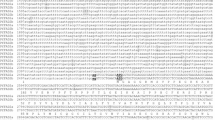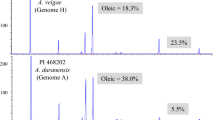Abstract
Crambe (Crambe abyssinica Hochst ex. R. E. Fries) is an ideal crop for industrial oil production because of its high erucic acid content (C22:1, approx. 60 %) in its seed oil. The value of crambe oil can be improved by increasing C22:1 content or reducing polyunsaturated fatty acids (PUFA). The FAD2 gene plays a critical role in PUFA biosynthesis. To identify targets for breeding, we characterized FAD2 in crambe for copy number and expression profile. Seven copies of FAD2 were detected in allohexaploid crambe. Three genes (CaFAD2-C1, -C2 and -C3) were expressed in multiple tissues, including root, seedling, leaf, flower, bud and developing seeds. In developing seeds, the expression of these genes was upregulated with CaFAD2-C3, being expressed predominantly with a peak at 20 days after pollination. This gene is therefore a promising candidate gene for determining PUFA levels in seed oil. Four other FAD2 genes were considered to be “pseudo-genes” as they harbour internal stop codons and were not expressed. Among the six crambe varieties with consistent variation in oil composition, no nucleotide polymorphisms were found in the CaFAD2-C1, -C2 and -C3 genes. In seeds at 30 days after pollination, statistically significant expression level polymorphisms for only one gene, CaFAD2-C2, was found among the varieties. However, although significantly different, the difference in expression was small and did not explain the variation in oil composition. Given the absence of genetic variation in CaFAD2 genes in crambe breeding lines, breeding for high erucic acid content calls for a molecular breeding approach whereby mutations are chemically induced to increase the genetic variation.




Similar content being viewed by others
References
Aldrich J, Cullis CA (1993) RAPD analysis in flax: optimization of yield and reproducibility using klen Taq 1 DNA polymerase, chelex 100, and gel purification of genomic DNA. Plant Mol Biol Rep 11(2):128–141
Beló A, Zheng P, Luck S, Shen B, Meyer DJ, Li B, Tingey S, Rafalski A (2008) Whole genome scan detects an allelic variant of fad2 associated with increased oleic acid levels in maize. Mol Genet Genomics 279(1):1–10
Buggs RJA, Renny-Byfield S, Chester M, Jordon-Thaden IE, Viccini LF, Chamala S, Leitch AR, Schnable PS, Bradley Barbazuk W, Soltis PS, Soltis DE (2012) Next-generation sequencing and genome evolution in allopolyploids. Am J Bot 99(2):372–382
Carlsson AS, Clayton D, Salentijn E, Toonen M, Stymne S, Dyer WJ, Bowles D (2007) Oil crop platforms for industrial uses. CPL Press, Newbury
Chen X, Truksa M, Snyder CL, El-Mezawy A, Shah S, Weselake RJ (2011) Three homologous genes encoding sn-glycerol-3-phosphate acyltransferase 4 exhibit different expression patterns and functional divergence in Brassica napus. Plant Physiol 155(2):851–865
Falasca S, Flores N, Lamas M, Carballo SM, Anschau A (2010) Crambe abyssinica: an almost unknown crop with a promissory future to produce biodiesel in Argentina. Int J Hydrogen Energy 35(11):5808–5812
Griffin PC, Robin C, Hoffmann AA (2011) A next-generation sequencing method for overcoming the multiple gene copy problem in polyploid phylogenetics, applied to Poa grasses. BMC Biol 9:19
Gurr MI, Blades J, Appleby RS (1972) Studies on seed-oil triglycerides. The composition of Crambé abyssinica triglycerides during seed maturation. Eur J Biochem 29(2):362–368
Heppard EP, Kinney AJ, Stecca KL, Miao GH (1996) Developmental and growth temperature regulation of two different microsomal [omega]-6 desaturase genes in soybeans. Plant Physiol 110(1):311–319
Hu X, Sullivan-Gilbert M, Gupta M, Thompson SA (2006) Mapping of the loci controlling oleic and linolenic acid contents and development of fad2 and fad3 allele-specific markers in canola (Brassica napus L.). Theor Appl Genet 113(3):497–507
Hu Y, Wu G, Cao Y, Wu Y, Xiao L, Li X, Lu C (2009) Breeding response of transcript profiling in developing seeds of Brassica napus. BMC Mol Biol 10(1):49
Hutcheon C, Ditt R, Beilstein M, Comai L, Schroeder J, Goldstein E, Shewmaker C, Nguyen T, De Rocher J, Kiser J (2010) Polyploid genome of Camelina sativa revealed by isolation of fatty acid synthesis genes. BMC Plant Biol 10(1):233
Jadhav A, Katavic V, Marillia EF, Michael Giblin E, Barton DL, Kumar A, Sonntag C, Babic V, Keller WA, Taylor DC (2005) Increased levels of erucic acid in Brassica carinata by co-suppression and antisense repression of the endogenous FAD2 gene. Metab Eng 7(3):215–220
Kang J, Snapp AR, Lu C (2011) Identification of three genes encoding microsomal oleate desaturases (FAD2) from the oilseed crop Camelina sativa. Plant Physiol Biochem 49(2):223–229
Kim MJ, Kim H, Shin JS, Chung CH, Ohlrogge JB, Suh MC (2006) Seed-specific expression of sesame microsomal oleic acid desaturase is controlled by combinatorial properties between negative cis-regulatory elements in the SeFAD2 promoter and enhancers in the 5-UTR intron. Mol Genet Genomics 276(4):351–368
Leppik EE, White GA (1975) Preliminary assessment of Crambe germplasm resources. Euphytica 24(3):681–689
Li X, van Loo EN, Gruber J, Fan J, Guan R, Frentzen M, Stymne S, Zhu LH (2012) Development of ultra-high erucic acid oil in the industrial oil crop Crambe abyssinica. Plant Biotechnol J 10(7):862–870
Liu Q, Brubaker CL, Green AG, Marshall DR, Sharp PJ, Singh SP (2001) Evolution of the FAD2-1 fatty acid desaturase 5’UTR intron and the molecular systematics of Gossypium (Malvaceae). Am J Bot 88(1):92–102
Liu Q, Singh SP, Green AG (2002) High-stearic and high-oleic cottonseed oils produced by hairpin RNA-mediated post-transcriptional gene silencing. Plant Physiol 129(4):1732
Lu C, Napier JA, Clemente TE, Cahoon EB (2011) New frontiers in oilseed biotechnology: meeting the global demand for vegetable oils for food, feed, biofuel, and industrial applications. Curr Opin Biotechnol 22(2):252–259
Makarenko SP, Dudareva LV, Katyshev AI, Konenkina TA, Nazarova AV, Rudikovskaya EG, Sokolova NA, Chernikova VV, Konstantinov YM (2011) The effect of low temperatures on fatty acid composition of crops with different cold resistance. Biochem (Moscow) Suppl Ser A Membr Cell Biol 5(1):64–69
Martínez-Rivas JM, Sperling P, Lühs W, Heinz E (2001) Spatial and temporal regulation of three different microsomal oleate desaturase genes (FAD2) from normal-type and high-oleic varieties of sunflower (Helianthus annuus L.). Mol Breed 8(2):159–168
Mastebroek HD, Wallenburg SC, Van Soest LJM (1994) Variation for agronomic characteristics in crambe (Crambe abyssinica Hochst. ex Fries). Ind Crops Prod 2(2):129–136
Mietkiewska E, Hoffman TL, Brost JM, Giblin EM, Barton DL, Francis T, Zhang Y, Taylor DC (2008) Hairpin-RNA mediated silencing of endogenous FAD2 gene combined with heterologous expression of Crambe abyssinica FAE gene causes an increase in the level of erucic acid in transgenic Brassica carinata seeds. Mol Breed 22(4):619–627
Ohlrogge J (1995) Lipid biosynthesis. Plant Cell 7(7):957
Okuley J, Lightner J, Feldmann K, Yadav N, Lark E (1994) Arabidopsis FAD2 gene encodes the enzyme that is essential for polyunsaturated lipid synthesis. Plant Cell 6(1):147–158
Oliva ML, Shannon JG, Sleper DA, Ellersieck MR, Cardinal AJ, Paris RL, Lee JD (2006) Stability of fatty acid profile in soybean genotypes with modified seed oil composition. Crop Sci 46(5):2069–2075
Paulose B, Kandasamy S, Dhankher OP (2010) Expression profiling of Crambe abyssinica under arsenate stress identifies genes and gene networks involved in arsenic metabolism and detoxification. BMC Plant Biol 10:108
Pham AT, Lee JD, Shannon JG, Bilyeu K (2010) Mutant alleles of FAD2-1A and FAD2-1B combine to produce soybeans with the high oleic acid seed oil trait. BMC Plant Biol 10(1):195
Pham AT, Lee JD, Shannon JG, Bilyeu KD (2011) A novel FAD2-1 A allele in a soybean plant introduction offers an alternate means to produce soybean seed oil with 85% oleic acid content. Theor Appl Genet 23(5):793–802
Pirtle IL, Kongcharoensuntorn W, Nampaisansuk M, Knesek JE, Chapman KD, Pirtle RM (2001) Molecular cloning and functional expression of the gene for a cotton Δ-12 fatty acid desaturase (FAD2). Biochimica et Biophysica Acta (BBA)-Gene Struct Exp 1522 (2):122–129
Rudloff E, Wang Y (2011) Crambe. In: Kole C (ed) Wild crop relatives: genomic and breeding resources. Springer-Verlag, Berlin, pp 97–116
Salentijn EMJ, Goryunova SV, Bas N, van der Meer IM, van den Broeck HC, Bastien T, Gilissen LJ, Smulders MJ (2009) Tetraploid and hexaploid wheat varieties reveal large differences in expression of alpha-gliadins from homoeologous Gli-2 loci. BMC Genomics 10:48
Sasongko ND, Möllers C (2005) Toward increasing erucic acid content in oilseed rape (Brassica napus L.) through the combination with genes for high oleic acid. J Am Oil Chem Soc 82(6):445–449
Scheffler JA, Sharpe AG, Schmidt H, Sperling P, Parkin IAP, Lühs W, Lydiate DJ, Heinz E (1997) Desaturase multigene families of Brassica napus arose through genome duplication. Theor Appl Genet 94(5):583–591
Schierholt A, Becker H, Ecke W (2000) Mapping a high oleic acid mutation in winter oilseed rape (Brassica napus L.). Theor Appl Genet 101(5):897–901
Schlueter JA, Vasylenko-Sanders IF, Deshpande S, Yi J, Siegfried M, Roe BA, Schlueter SD, Scheffler BE, Shoemaker RC (2007) The FAD2 gene family of soybean: insights into the structural and functional divergence of a paleopolyploid genome. Crop Sci 47(S1):S-14–S-26
Shanklin J, Whittle E, Fox BG (1994) Eight histidine residues are catalytically essential in a membrane-associated iron enzyme, stearoyl-CoA desaturase, and are conserved in alkane hydroxylase and xylene monooxygenase. Biochemistry 33(43):12787–12794
Shi J, Cao Y, Fan X, Li M, Wang Y, Ming F (2012) A rice microsomal delta-12 fatty acid desaturase can enhance resistance to cold stress in yeast and Oryza sativa. Mol Breed 29(3):743–757
Sivaraman I, Arumugam N, Sodhi YS, Gupta V, Mukhopadhyay A, Pradhan AK, Burma PK, Pental D (2004) Development of high oleic and low linoleic acid transgenics in a zero erucic acid Brassica juncea L (Indian mustard) line by antisense suppression of the fad2 gene. Mol Breed 13(4):365–375
Slabas AR, Hanley Z, Schierer T, Rice D, Turnbull A, Rafferty J, Simon B, Brown A (2001) Acyltransferases and their role in the biosynthesis of lipids-opportunities for new oils. J Plant Physiol 158(4):505–513
Slade AJ, Fuerstenberg SI, Loeffler D, Steine MN, Facciotti D (2005) A reverse genetic, nontransgenic approach to wheat crop improvement by TILLING. Nat Biotechnol 23(1):75–81
Soltis PS, Burleigh JG, Chanderbali AS, Yoo MJ, Soltis DE (2010) Gene and genome duplications in plants. In: Dittmar K, Liberles D (eds) Evolution after gene duplication. Wiley, Hoboken, NJ, USA, pp 269–298
Stoutjesdijk PA, Singh SP, Liu Q, Hurlstone CJ, Waterhouse PA, Green AG (2002) hpRNA-mediated targeting of the Arabidopsis FAD2 gene gives highly efficient and stable silencing. Plant Physiol 129(4):1723
Tamura K, Dudley J, Nei M, Kumar S (2007) MEGA4: molecular evolutionary genetics analysis (MEGA) software version 4.0. Mol Biol Evol 24(8):1596–1599
Tang GQ, Novitzky WP, Carol Griffin H, Huber SC, Dewey RE (2005) Oleate desaturase enzymes of soybean: evidence of regulation through differential stability and phosphorylation. Plant J 44(3):433–446
Tanhuanpää P, Vilkki J, Vihinen M (1998) Mapping and cloning of FAD2 gene to develop allele-specific PCR for oleic acid in spring turnip rape (Brassica rapa ssp. oleifera). Mol Breed 6:543–550
Van Poecke RMP, Sato M, Lenarz-Wyatt L, Weisberg S, Katagiri F (2007) Natural variation in RPS2-mediated resistance among Arabidopsis accessions: correlation between gene expression profiles and phenotypic responses. Plant Cell 19(12):4046–4060
Varshney RK, Nayak SN, May GD, Jackson SA (2009) Next-generation sequencing technologies and their implications for crop genetics and breeding. Trends Biotechnol 27(9):522–530
Wang Y, Luo P (1998) Intergeneric hybridization between Brassica species and Crambe abyssinica. Euphytica 101(1):1–7
Yuan SW, Wu XL, Liu ZH, Luo HB, Huang RZ (2012) Abiotic stresses and phytohormones regulate expression of FAD2 gene in Arabidopsis thaliana. Agric Sci China 11(1):62–72
Zanetti F, Vamerali T, Bona S, Mosca G (2006) Can we “cultivate” erucic acid in southern Europe? Italian J Agro 1(1):3–10
Acknowledgments
This work was supported by the EU-project ICON (Industrial crops producing added value oils for novel chemicals) and with co-funding of a Dutch R&D program Biobased Economy (Kennis Basis Biobased Economy).
Author information
Authors and Affiliations
Corresponding author
Electronic supplementary material
Below is the link to the electronic supplementary material.
Rights and permissions
About this article
Cite this article
Cheng, J., Salentijn, E.M.J., Huang, B. et al. Isolation and characterization of the omega-6 fatty acid desaturase (FAD2) gene family in the allohexaploid oil seed crop Crambe abyssinica Hochst. Mol Breeding 32, 517–531 (2013). https://doi.org/10.1007/s11032-013-9886-0
Received:
Accepted:
Published:
Issue Date:
DOI: https://doi.org/10.1007/s11032-013-9886-0




